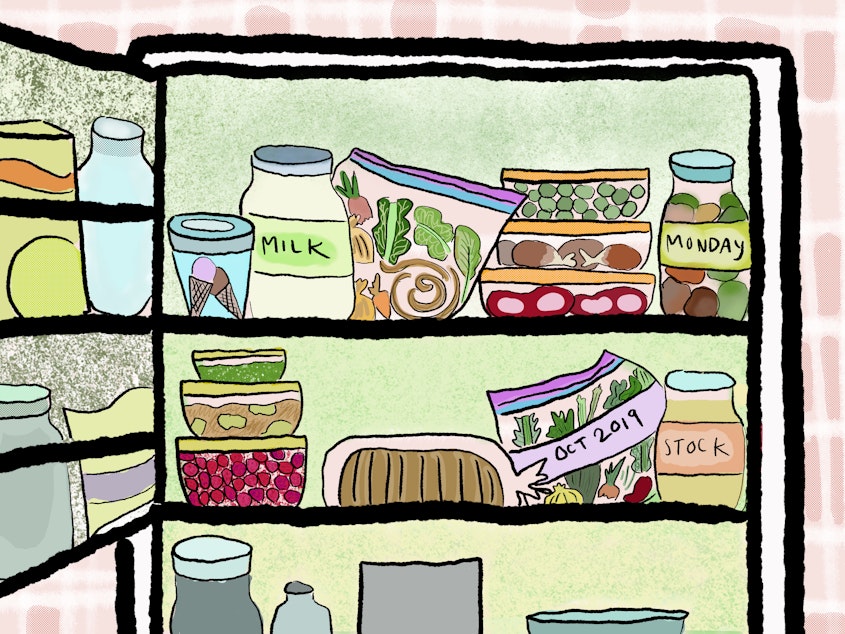Roundup: Your Tips To Fight Food Waste

Food waste is a big problem in the United States, where a typical household of four tosses out about $1,600 worth of food annually. So, Life Kit did a deep dive on how how to reduce food waste.
In planning that episode, the office was abuzz with conversations about our own tricks and tips to save food — from recipes to compost tips. This made us wonder what other wisdom was out there. So we asked you!
We were overwhelmed by your collective knowledge and thriftiness. Our roundup is by no means an exhaustive list, but below are a few tips we felt inspired by. (If you want to join the conversations, you can find them here on Instagram and Facebook.)
Your tips from Instagram
1. Used coffee grounds can be dried and used in a steak rub or mixed with coconut oil and sugar and used as a body scrub. — @Chefanniecarroll
Sponsored
2. Collect vegetable scraps such as carrot tops, ends of onions, celery leaves and ends etc. Keep in freezer in a mason jar. When you have about three full jars, empty them into a large pot and add water to cover. If you have whole black peppercorns, add a few to the pot and any fresh herbs like parsley or thyme, throw a few sprigs in the pot. Add 1-2 tsp of salt or to taste. Boil for 20 to 30 minutes. Strain and discard boiled scraps to your compost. Let cool and freeze or refrigerate if you plan to use [the broth]. — @vegan.wolverine
3. I bring in anything and everything to my office. Weird chips that we didn't like? Leftover birthday cake? They'll eat ANYTHING! — @zoe.khh
4. We keep our pantry stocked with dry foods so we don't feel like we always have to have fresh food around that doesn't get eaten and goes to waste. So we supplement our diets with canned fruits, vegetables, stuff like that. —@Bohemianrhapsody29
5. One thing we can all do is change our language. Start using the term "food scraps" rather than "waste." This material is a resource not a waste. Changing the language can catalyze a change in value and perception. —@Livingrootscomposttea
6. We freeze leftovers if not eaten in a couple of days. Soups and other soft foods are frozen in silicone muffin tins so we can thaw one or two servings rather than a quart. [Also,] wash and reuse takeout containers to bring home leftovers when we eat out rather than using restaurant's styrofoam boxes. — @Dianee229
Sponsored
7. I switched to shopping for two-three days at a time. Also meal prep the food. That alone has made the biggest change. The refrigerator is quite empty and stays organized so there is nothing hiding and going bad. — @n8talee
8. Try to use every part of a vegetable or animal for cooking. Kale stalks are delicious and tender if you cut them really small and sauté them well; same with broccoli stalks and cilantro stems. The greens surrounding cauliflower can be used the same way as collard greens. — @xincitanz
9. To avoid the dreaded lettuce tub rot, it's best to either stab holes in the package (be careful) or transfer to a container with air flow. Adding a paper towel to the container usually helps to prevent the lettuce from rotting in the residual water in a closed container, with no air circulation. — @larryparry1
10. Label everything. Take a photo of fridge interior when you leave for work so if you need to go shopping you don't buy duplicates. Also [the] fridge photo is shareable. If after school kid says there's nothing to eat, send photo. If you want after school kid to start prepping dinner, send photo. — @Joanietells
Your tips from Facebook
Sponsored
11. Pesto is great for a ton of herbs, not just basil (cilantro and parsley). Wilted spinach goes in spaghetti or soups. Wrinkled tomatoes are great for roasting with garlic, olive oil, salt and thyme for a pasta sauce. — Georgina Garretson
12. I have a system that I called the "reverse shopping list" - where, before I do my weekly grocery shop, I go through my pantry, fridge and freezer to see what I already have and write them all down. Often I can get at least two or three meals/snacks for the week based on what I already have, and it encourages me to actually use those items in the back of the freezer/pantry, instead of hoarding bags of lentils and cans of beans for literal years. — Jacqueline C. Lawler
Folks also suggested resources they use to waste less and share more:
Have A Plant, Produce for Better Health Foundation's site, has tips for how to store and prepare produce — shared by @T.rexskittles
The Real Food Dietitians, a resource for recipes and meal planning created by two registered dietitians — shared by @T.rexskittles
Sponsored
Buy Nothing Project, a network where people can give, receive, share and lend resources — shared by Georgina Garretson
Plan To Eat, an app for shopping and meal planning — shared by Shauna Perry
If you have tips on how to fight food waste, give us a shout on Twitter at @NPRLifeKit. [Copyright 2019 NPR]
